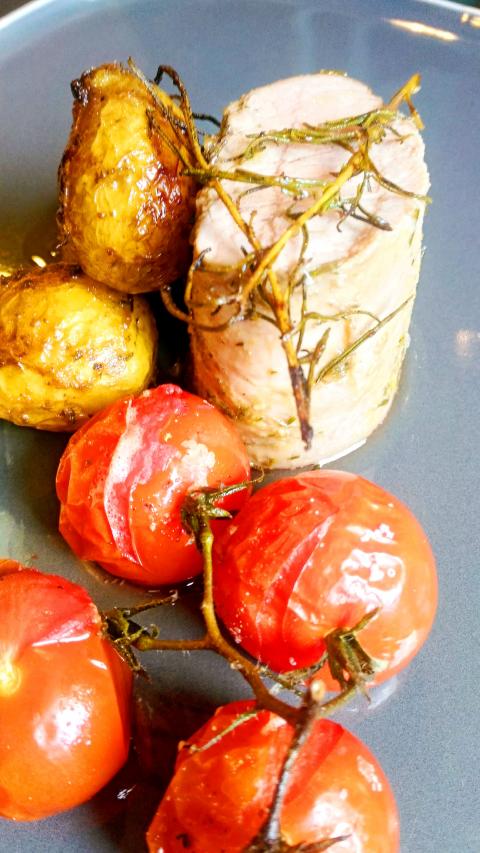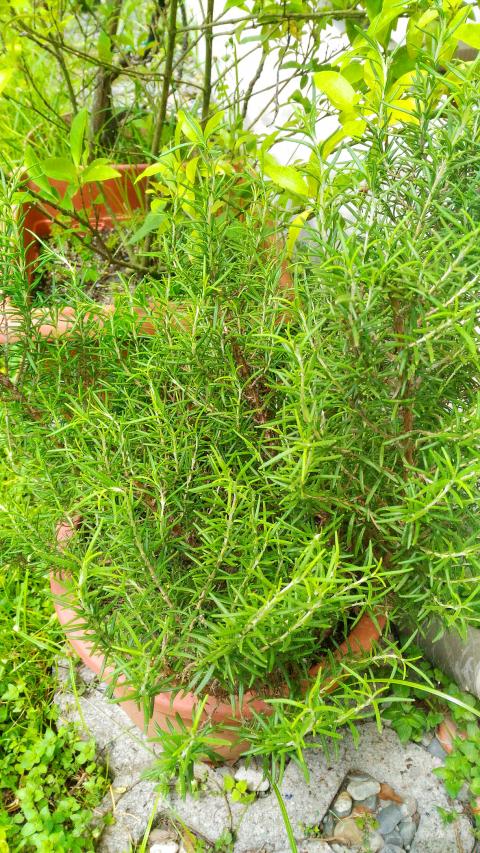Its versatility in the kitchen is amazing, but what is even more remarkable about rosemary is how easy it is to grow and maintain. No green thumbs required! It has the added advantage of thriving in containers, so a tub on the balcony or even a pot on the kitchen window is all that is necessary. In Taiwan, the only danger, apart from complete neglect, is from damp, and just ensuring that it gets sufficient sunshine and enough water is all that is required. It’s a perennial, so you don’t ever have to worry about running out. Most importantly, when you grow your own, you can access this powerhouse of flavor and aroma at any time, and never have to worry about stale, bland dried rosemary that has been sitting in the spice drawer for far too long. It is always fresh, full of character and a pretty decorative feature either indoors in a pot or outdoors as part of a more ambitious herb garden.
Even with the recent wet weather, rosemary has a way of evoking dry, fragrant landscapes, perhaps the hills of Provence in summer or some other Mediterranean idyll. It can be incorporated into all kinds of dishes, everything from grilled meats and fried fish to sweets (its perfectly delicious with apple tart or if you are feeling especially adventurous, paired with a dark chocolate brownie). Rosemary can also be infused with oil to good effect for use both in the kitchen and around the house, or brewed with other herbs into a delicious and vitalizing tea.
The scientific name for rosemary is rosmarinus officinalis, with “rosmarinus” deriving from the Latin words “ros” meaning “dew” and “marinus” for ocean. In mythology, the derivation has been said to come from “Rose of Mary,” associated with a story of the Virgin Mary turning the white flowers of a bed of rosemary blue after resting upon it. In more recent history, rosemary is associated with the tragedy of the Gallipoli landings by Australian and New Zealand troops in World War One, as it grows wild on the peninsula and is now often worn as part of the ANZAC day commemoration. Rosemary, with its clean, refreshing smell, was also considered sacred by many early cultures and, on a more mundane level, is helpful with pest control in the garden.

Photo: Ian Bartholomew
There are many cultivars of rosemary, with upright and trailing versions, with spiky leaves, fat soft leaves or yellow streaked leaves; it also flowers very prettily, with blue, pink or white flowers. Most can be used interchangeably in the kitchen. One medium sized pot from the gardening shop can be made to go a long way with a bit of careful husbanding. Rosemary can easily be grown from cuttings, so if you have a plant of rosemary that you particularly like, take some cuttings and turn your single plant into a whole garden of rosemary in just a couple of months.
Rosemary is usually used in relatively small quantities so in terms of nutritional value, it does not provide much value, but it does contain a wide variety of phytochemicals which have been used extensively in various traditional medicinal remedies. At its most basic, inhaling rosemary oil is said to relieve headache and help alleviate depression, and even if it doesn’t, it is quite a pleasant thing to do, especially if paired with a nice fruity olive oil. Some even say that the smell of rosemary helps to improve memory, and Shakespeare has given this idea greater currency with the phrase “rosemary, that is for remembrance,” spoken by Ophelia in the play Hamlet. Science does back this up to some extent, with studies showing memory improvement supposedly induced by the scent of rosemary, but despite my own great fondness for this herb I have not noticed any improvement for myself in this area. High doses of rosemary, quantities that most people would not be expected to ingest in a single sitting, can have detrimental effects on health, even inducing coma or causing miscarriage, but this is at the fringes of normality, and any normal, or even copiously generous, addition to food is not likely to be harmful.
Rosemary and balsamic roasted pork tenderloin

Photo: Ian Bartholomew
Recipe(serves four)
This is a roast that takes next to no time to put together but has a nicely sophisticated feel so that it can hold its own as a special meal despite its ease of preparation. Good quality tenderloin that has been carefully trimmed of loose meat and any lingering membrane makes for the best eating, soft and tender under the knife, and the use of ample quantities of fresh rosemary gives an intense fragrance and strong herbal notes to the meat.
Ingredients
2 x pork tenderloin, trimmed
12 baby potatoes, well scrubbed
2 zucchini, cut into large chunks
12 cherry tomatoes
6 sprigs of rosemary
4 cloves garlic
2 tsp aged balsamic vinegar
2 tsp extra-virgin olive oil
Sea salt and black pepper for seasoning
Directions
1. Trim the loose bits of meat off the tenderloin to create a neat roll. The bits of extra meat can be sliced up with a sharp knife and put aside for quick Chinese-style stir-fries.
2. Bring a pot of water to a boil and steam the baby potatoes over high heat for 15 minutes.
3. In a food processor or using a mortar and pestle, mash together the garlic, rosemary leaves, balsamic vinegar, olive oil and salt and pepper into a thick paste. Rub it over the tenderloin.
4. Place the zucchini and cherry tomatoes in another baking tray and drizzle with olive oil, seasoning generously with salt and pepper.
5. In an oven pre-heated to 200c, place a metal baking tray with a little oil and heat it for 5 minutes. Remove and place the meat into the hot tray.
6. Quickly toss the hot steamed potatoes in what remains of the herb and oil mixture and add to the baking tray.
7. Place the two trays, one with meat and potatoes, the other with the zucchini and tomato on an upper shelf of the oven for 10 minutes.
8. Remove the meat tray from the oven and turn the tenderloin over. Cook for another 6-8 minutes or until internal temperature reaches 60c at its thickest point. Remove both trays.
9. Allow the meat to rest for at least 10 minutes before cutting into four sections.
Ian Bartholomew runs Ian’s Table, a small guesthouse in Hualien. He has lived in Taiwan for many years writing about the food scene and has decided that until you look at farming, you know nothing about the food you eat. He can be contacted at Hualien202@gmail.com.

Following the shock complete failure of all the recall votes against Chinese Nationalist Party (KMT) lawmakers on July 26, pan-blue supporters and the Chinese Communist Party (CCP) were giddy with victory. A notable exception was KMT Chairman Eric Chu (朱立倫), who knew better. At a press conference on July 29, he bowed deeply in gratitude to the voters and said the recalls were “not about which party won or lost, but were a great victory for the Taiwanese voters.” The entire recall process was a disaster for both the KMT and the Democratic Progressive Party (DPP). The only bright spot for

Water management is one of the most powerful forces shaping modern Taiwan’s landscapes and politics. Many of Taiwan’s township and county boundaries are defined by watersheds. The current course of the mighty Jhuoshuei River (濁水溪) was largely established by Japanese embankment building during the 1918-1923 period. Taoyuan is dotted with ponds constructed by settlers from China during the Qing period. Countless local civic actions have been driven by opposition to water projects. Last week something like 2,600mm of rain fell on southern Taiwan in seven days, peaking at over 2,800mm in Duona (多納) in Kaohsiung’s Maolin District (茂林), according to

Aug. 11 to Aug. 17 Those who never heard of architect Hsiu Tse-lan (修澤蘭) must have seen her work — on the reverse of the NT$100 bill is the Yangmingshan Zhongshan Hall (陽明山中山樓). Then-president Chiang Kai-shek (蔣介石) reportedly hand-picked her for the job and gave her just 13 months to complete it in time for the centennial of Republic of China founder Sun Yat-sen’s birth on Nov. 12, 1966. Another landmark project is Garden City (花園新城) in New Taipei City’s Sindian District (新店) — Taiwan’s first mountainside planned community, which Hsiu initiated in 1968. She was involved in every stage, from selecting

As last month dawned, the Democratic Progressive Party (DPP) was in a good position. The recall campaigns had strong momentum, polling showed many Chinese Nationalist Party (KMT) lawmakers at risk of recall and even the KMT was bracing for losing seats while facing a tsunami of voter fraud investigations. Polling pointed to some of the recalls being a lock for victory. Though in most districts the majority was against recalling their lawmaker, among voters “definitely” planning to vote, there were double-digit margins in favor of recall in at least five districts, with three districts near or above 20 percent in